Cloud-Based Solutions for Monitoring Coastal Ecosystems and the Prioritization of Restoration Efforts Across Belize
Abstract
Highlights
- LandTrendr outperformed CCDC-SMA for mangrove change detection in Belize, achieving slightly better recall and more balanced precision-recall trade-offs across parameter variation.
- The best performing algorithm run estimated 540 hectares of mangrove loss from 2017 to 2024 in Belize, identifying 136 hectares of disturbance within protected areas.
- The methodology demonstrated here provides a replicable framework for applying change detection algorithms for national-level mangrove monitoring, supporting Belize’s Blue Bond commitments, REDD+ reporting requirements, and evidence-based restoration planning through annual extent updates.
- Change areas identified provide evidence to support Belize’s National Mangrove Restoration Action Plan through data-driven restoration planning, and targeted enforcement strategies to ensure long-term resilience and the protection of coastal ecosystems.
Abstract
1. Introduction
Literature Review
2. Materials and Methods
2.1. Determining the Study Area
2.2. Field Data for Validation
2.3. Change Detection
2.3.1. Continuous Change Detection and Classification—Spectral Mixture Analysis
2.3.2. Landsat-Based Detection of Trends in Disturbance and Recovery
2.4. Accuracy Assessment
3. Results
3.1. Change in Mangroves
3.2. LandTrendr
3.3. CCDC-SMA
4. Discussion
4.1. LandTrendr Compared to CCDC-SMA
4.2. Limitations
4.3. Future Directions
5. Conclusions
Author Contributions
Funding
Data Availability Statement
Acknowledgments
Conflicts of Interest
Appendix A. Tables
| Control End-Members (c) | |||||
|---|---|---|---|---|---|
| Band | Soil | Green Veg. | Cloud | Shade | NPV |
| B1 | 2000 | 500 | 9000 | 0 | 1400 |
| B2 | 3000 | 900 | 9600 | 0 | 1700 |
| B3 | 3400 | 400 | 8000 | 0 | 2200 |
| B4 | 5800 | 6100 | 7800 | 0 | 3000 |
| B5 | 6000 | 3000 | 7200 | 0 | 5500 |
| B6 | 5800 | 1000 | 6500 | 0 | 3000 |
| Run Alias | Precision | Recall | Overall Accuracy | False-Positive Rate |
|---|---|---|---|---|
| MMU11 | 0.94 | 0.23 | 0.71 | 0.01 |
| MMU5 | 0.95 | 0.27 | 0.73 | 0.01 |
| MMU1 | 0.80 | 0.36 | 0.74 | 0.05 |
| MS4 | 0.83 | 0.38 | 0.75 | 0.04 |
| MS6 | 0.83 | 0.38 | 0.75 | 0.04 |
| MS12 | 0.80 | 0.36 | 0.74 | 0.05 |
| RT025 | 0.79 | 0.33 | 0.73 | 0.05 |
| RT05 | 0.80 | 0.36 | 0.74 | 0.05 |
| RT075 | 0.77 | 0.36 | 0.73 | 0.06 |
| BMP05 | 0.79 | 0.35 | 0.73 | 0.05 |
| BMP1 | 0.80 | 0.36 | 0.74 | 0.05 |
| BMP125 | 0.80 | 0.12 | 0.67 | 0.02 |
| Final | 0.83 | 0.38 | 0.75 | 0.04 |
| Run Alias | Precision | Recall | Overall Accuracy | False-Positive Rate |
|---|---|---|---|---|
| c0 | 0.65 | 0.23 | 0.68 | 0.07 |
| pv0x1 | 0.67 | 0.24 | 0.67 | 0.07 |
| pv0y1 | 0.63 | 0.26 | 0.68 | 0.09 |
| pv0x3 | 0.59 | 0.24 | 0.66 | 0.09 |
| c2600 | 0.94 | 0.24 | 0.72 | 0.01 |
| pv2600x1 | 0.89 | 0.24 | 0.71 | 0.02 |
| pv2600y1 | 0.94 | 0.23 | 0.71 | 0.01 |
| pv2600x3 | 0.93 | 0.21 | 0.71 | 0.01 |
| c7000 | 1 | 0.17 | 0.70 | 0 |
| pv7000x1 | 1 | 0.17 | 0.70 | 0 |
| pv7000y1 | 1 | 0.12 | 0.68 | 0 |
| pv7000x3 | 1 | 0.11 | 0.68 | 0 |
| c10000 | 1 | 0.12 | 0.68 | 0 |
| pv10000x1 | 1 | 0.12 | 0.68 | 0 |
| pv10000y1 | 1 | 0.11 | 0.68 | 0 |
| pv10000x3 | 1 | 0.09 | 0.67 | 0 |
Appendix B. Figures

References
- Spalding, M.D.; Leal, M. The State of the World’s Mangroves 2024; Global Mangrove Alliance: Arlington, VA, USA, 2024. [Google Scholar]
- Government of Belize. Updated Nationally Determined Contribution; Government of Belize: Belmopan, Belize, 2021.
- Menéndez, P.; Losada, I.J.; Torres-Ortega, S.; Narayan, S.; Beck, M.W. The Global Flood Protection Benefits of Mangroves. Sci. Rep. 2020, 10, 4404. [Google Scholar] [CrossRef]
- The Nature Conservancy. Belize Blue Bonds for Ocean Conservation; The Nature Conservancy: Arlington, VA, 2023. [Google Scholar]
- Maurya, K.; Mahajan, S.; Chaube, N. Remote Sensing Techniques: Mapping and Monitoring of Mangrove Ecosystem—A Review. Complex Intell. Syst. 2021, 7, 2797–2818. [Google Scholar] [CrossRef]
- Tran, T.V.; Reef, R.; Zhu, X. A Review of Spectral Indices for Mangrove Remote Sensing. Remote Sens. 2022, 14, 4868. [Google Scholar] [CrossRef]
- Zhang, Y.; Li, X.; Zhang, R.; Cheng, L.; Jia, M.; Zhao, C.; Guo, X.; Zeng, H.; Yu, W.; Shi, Q.; et al. A Robust and Efficient Approach to Estimating the Age of Secondary Mangrove Forests Employing Time-Series Landsat Images and the CCDC Model. Int. J. Appl. Earth Obs. Geoinf. 2025, 143, 104789. [Google Scholar] [CrossRef]
- de Jong, S.M.; Shen, Y.; de Vries, J.; Bijnaar, G.; van Maanen, B.; Augustinus, P.; Verweij, P. Mapping Mangrove Dynamics and Colonization Patterns at the Suriname Coast Using Historic Satellite Data and the LandTrendr Algorithm. Int. J. Appl. Earth Obs. Geoinf. 2021, 97, 102293. [Google Scholar] [CrossRef]
- Awty-Carroll, K.; Bunting, P.; Hardy, A.; Bell, G. Using Continuous Change Detection and Classification of Landsat Data to Investigate Long-Term Mangrove Dynamics in the Sundarbans Region. Remote Sens. 2019, 11, 2833. [Google Scholar] [CrossRef]
- Cherrington, E.A.; Hernandez, B.E.; Trejos, N.A.; Smith, O.A.; Anderson, E.R.; Flores, A.I.; BC, G. Identification of Threatened and Resilient Mangroves in the Belize Barrier Reef System; Technical Report to the World Wildlife Fund; CATHALAC/SERVIR: Clayton, Panama, 2010. [Google Scholar]
- Cherrington, E.A.; Griffin, R.E.; Anderson, E.R.; Hernandez Sandoval, B.E.; Flores-Anderson, A.I.; Muench, R.E.; Markert, K.N.; Adams, E.C.; Limaye, A.S.; Irwin, D.E. Use of Public Earth Observation Data for Tracking Progress in Sustainable Management of Coastal Forest Ecosystems in Belize, Central America. Remote Sens. Environ. 2020, 245, 111798. [Google Scholar] [CrossRef]
- Cissell, J.R.; Canty, S.W.J.; Steinberg, M.K.; Simpson, L.T. Mapping National Mangrove Cover for Belize Using Google Earth Engine and Sentinel-2 Imagery. Appl. Sci. 2021, 11, 4258. [Google Scholar] [CrossRef]
- CATHALAC. The Development of a Land Use Land Cover Map of 2018 Using Sentinel-2 Images under the REDD+ Project in Belize; Product 5 Final Report; CATHALAC: Clayton, Panama, 2020. [Google Scholar]
- Hemati, M.; Hasanlou, M.; Mahdianpari, M.; Mohammadimanesh, F. A Systematic Review of Landsat Data for Change Detection Applications: 50 Years of Monitoring the Earth. Remote Sens. 2021, 13, 2869. [Google Scholar] [CrossRef]
- Gorelick, N.; Hancher, M.; Dixon, M.; Ilyushchenko, S.; Thau, D.; Moore, R. Google Earth Engine: Planetary-Scale Geospatial Analysis for Everyone. Remote Sens. Environ. 2017, 202, 18–27. [Google Scholar] [CrossRef]
- Pasquarella, V.J.; Arévalo, P.; Bratley, K.H.; Bullock, E.L.; Gorelick, N.; Yang, Z.; Kennedy, R.E. Demystifying LandTrendr and CCDC Temporal Segmentation. Int. J. Appl. Earth Obs. Geoinf. 2022, 110, 102806. [Google Scholar] [CrossRef]
- Murakami, T.; Tsutsumida, N. Comparative Global Assessment and Optimization of LandTrendr, CCDC, and BFAST Algorithms for Enhanced Urban Land Cover Change Detection Using Landsat Time Series. Remote Sens. 2025, 17, 2402. [Google Scholar] [CrossRef]
- Yin, X.; Li, M.; Lai, H.; Kou, W.; Chen, Y.; Chen, B. Utilizing Multi-Source Data and Cloud Computing Platform to Map Short-Rotation Eucalyptus Plantations Distribution and Stand Age in Hainan Island. Forests 2024, 15, 925. [Google Scholar] [CrossRef]
- Ding, N.; Li, M. Mapping Forest Abrupt Disturbance Events in Southeastern China—Comparisons and Tradeoffs of Landsat Time Series Analysis Algorithms. Remote Sens. 2023, 15, 5408. [Google Scholar] [CrossRef]
- Bunting, P.; Rosenqvist, A.; Lucas, R.M.; Rebelo, L.-M.; Hilarides, L.; Thomas, N.; Hardy, A.; Itoh, T.; Shimada, M.; Finlayson, C.M. The Global Mangrove Watch—A New 2010 Global Baseline of Mangrove Extent. Remote Sens. 2018, 10, 1669. [Google Scholar] [CrossRef]
- Kennedy, R.E.; Yang, Z.; Gorelick, N.; Braaten, J.; Cavalcante, L.; Cohen, W.B.; Healey, S. Implementation of the LandTrendr Algorithm on Google Earth Engine. Remote Sens. 2018, 10, 691. [Google Scholar] [CrossRef]
- Chen, S.; Woodcock, C.E.; Bullock, E.L.; Arévalo, P.; Torchinava, P.; Peng, S.; Olofsson, P. Monitoring Temperate Forest Degradation on Google Earth Engine Using Landsat Time Series Analysis. Remote Sens. Environ. 2021, 265, 112648. [Google Scholar] [CrossRef]
- Zhu, Z.; Woodcock, C.E. Continuous Change Detection and Classification of Land Cover Using All Available Landsat Data. Remote Sens. Environ. 2014, 144, 152–171. [Google Scholar] [CrossRef]
- Chen, S.; Olofsson, P.; Saphangthong, T.; Woodcock, C.E. Monitoring Shifting Cultivation in Laos with Landsat Time Series. Remote Sens. Environ. 2023, 288, 113507. [Google Scholar] [CrossRef]
- Souza, C.M.; Roberts, D.A.; Cochrane, M.A. Combining Spectral and Spatial Information to Map Canopy Damage from Selective Logging and Forest Fires. Remote Sens. Environ. 2005, 98, 329–343. [Google Scholar] [CrossRef]
- Kennedy, R.E.; Yang, Z.; Cohen, W.B. Detecting Trends in Forest Disturbance and Recovery Using Yearly Landsat Time Series: I. LandTrendr—Temporal Segmentation Algorithms. Remote Sens. Environ. 2010, 114, 2897–2910. [Google Scholar] [CrossRef]
- Cohen, W.B.; Yang, Z.; Healey, S.P.; Kennedy, R.E.; Gorelick, N. A LandTrendr Multispectral Ensemble for Forest Disturbance Detection. Remote Sens. Environ. 2018, 205, 131–140. [Google Scholar] [CrossRef]
- Yang, Y.; Erskine, P.D.; Lechner, A.M.; Mulligan, D.; Zhang, S.; Wang, Z. Detecting the Dynamics of Vegetation Disturbance and Recovery in Surface Mining Area via Landsat Imagery and LandTrendr Algorithm. J. Clean. Prod. 2018, 178, 353–362. [Google Scholar] [CrossRef]
- Fragal, E.H.; Silva, T.S.F.; de Moura, E.M.L. Reconstructing Historical Forest Cover Change in the Lower Amazon Floodplains Using the LandTrendr Algorithm. Acta Amaz. 2016, 46, 13–24. [Google Scholar] [CrossRef]
- Murillo-Sandoval, P.J.; Fatoyinbo, L.; Simard, M. Mangroves Cover Change Trajectories 1984–2020: The Gradual Decrease of Mangroves in Colombia. Front. Mar. Sci. 2022, 9, 892946. [Google Scholar] [CrossRef]
- Fromard, F.; Vega, C.; Proisy, C. Half a Century of Dynamic Coastal Change Affecting Mangrove Shorelines of French Guiana: A Case Study Based on Remote Sensing Data Analyses and Field Surveys. Mar. Geol. 2004, 208, 265–280. [Google Scholar] [CrossRef]
- Huang, X.; Fu, Y.; Ding, H.; Tang, G.; Ma, P.; Liu, L.; Xue, Y.; Wu, S.; Chen, Y. Inter-Annual Changes and Growth Trends Mapping of Mangrove Using Landsat Time Series Imagery. GISci. Remote Sens. 2025, 62, 2480422. [Google Scholar] [CrossRef]
- Ghosh, M.K.; Kumar, L.; Roy, C. Mapping Long-Term Changes in Mangrove Species Composition and Distribution in the Sundarbans. Forests 2016, 7, 305. [Google Scholar] [CrossRef]
- Sun, C.; Liu, Y.; Zhao, S.; Zhou, M.; Yang, Y.; Li, F. Classification Mapping and Species Identification of Salt Marshes Based on a Short-Time Interval NDVI Time-Series from HJ-1 Optical Imagery. Int. J. Appl. Earth Obs. Geoinf. 2016, 45, 27–41. [Google Scholar] [CrossRef]
- Olofsson, P.; Foody, G.M.; Herold, M.; Stehman, S.V.; Woodcock, C.E.; Wulder, M.A. Good Practices for Estimating Area and Assessing Accuracy of Land Change. Remote Sens. Environ. 2014, 148, 42–57. [Google Scholar] [CrossRef]
- Chan-Bagot, K.; Herndon, K.E.; Puzzi Nicolau, A.; Martín-Arias, V.; Evans, C.; Parache, H.; Mosely, K.; Narine, Z.; Zutta, B. Integrating SAR, Optical, and Machine Learning for Enhanced Coastal Mangrove Monitoring in Guyana. Remote Sens. 2024, 16, 542. [Google Scholar] [CrossRef]
- Evans, C.; Carey, L.; Guerra, F.; Cherrington, E.; Correa, E. Data for: Cloud-Based Solutions for Monitoring Coastal Ecosystems and Prioritization of Restoration Efforts Across Belize [Data Set]. Zenodo. 2025. Available online: https://zenodo.org/records/15328468 (accessed on 2 May 2025).
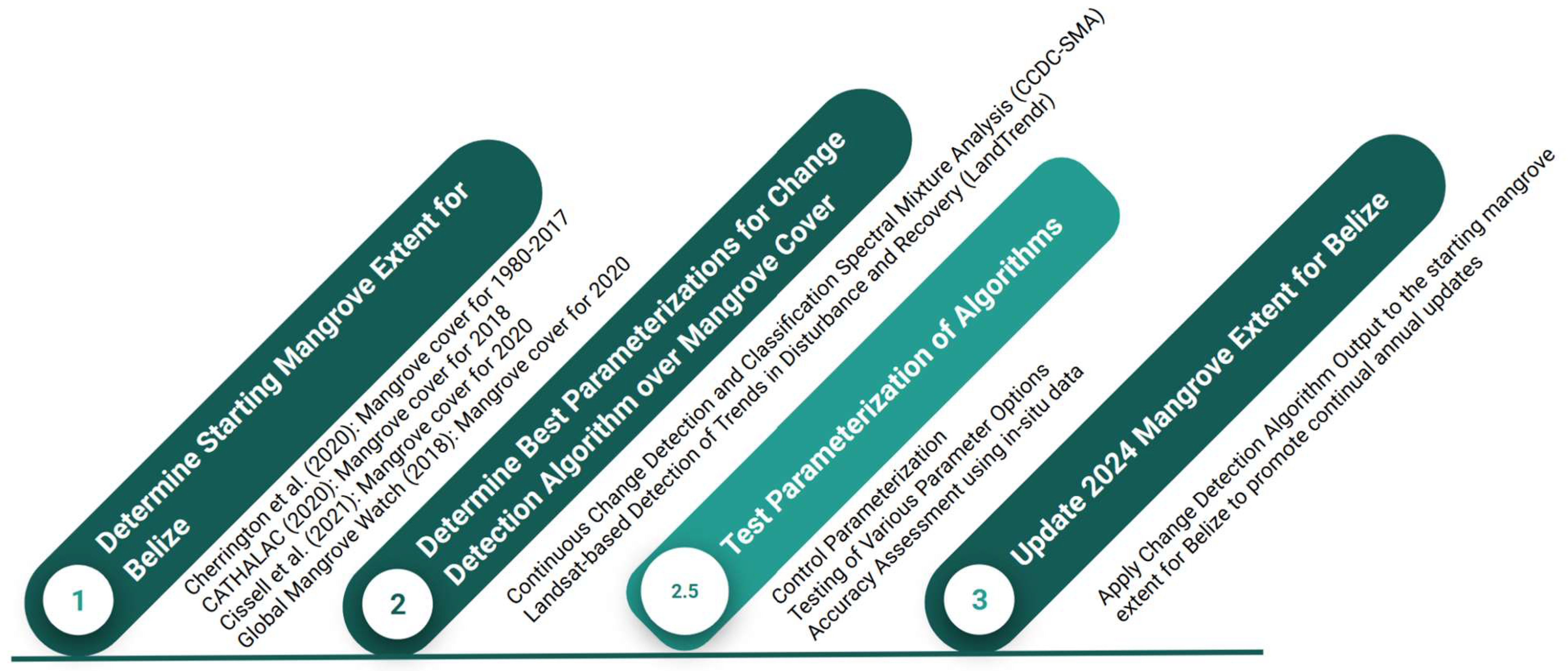
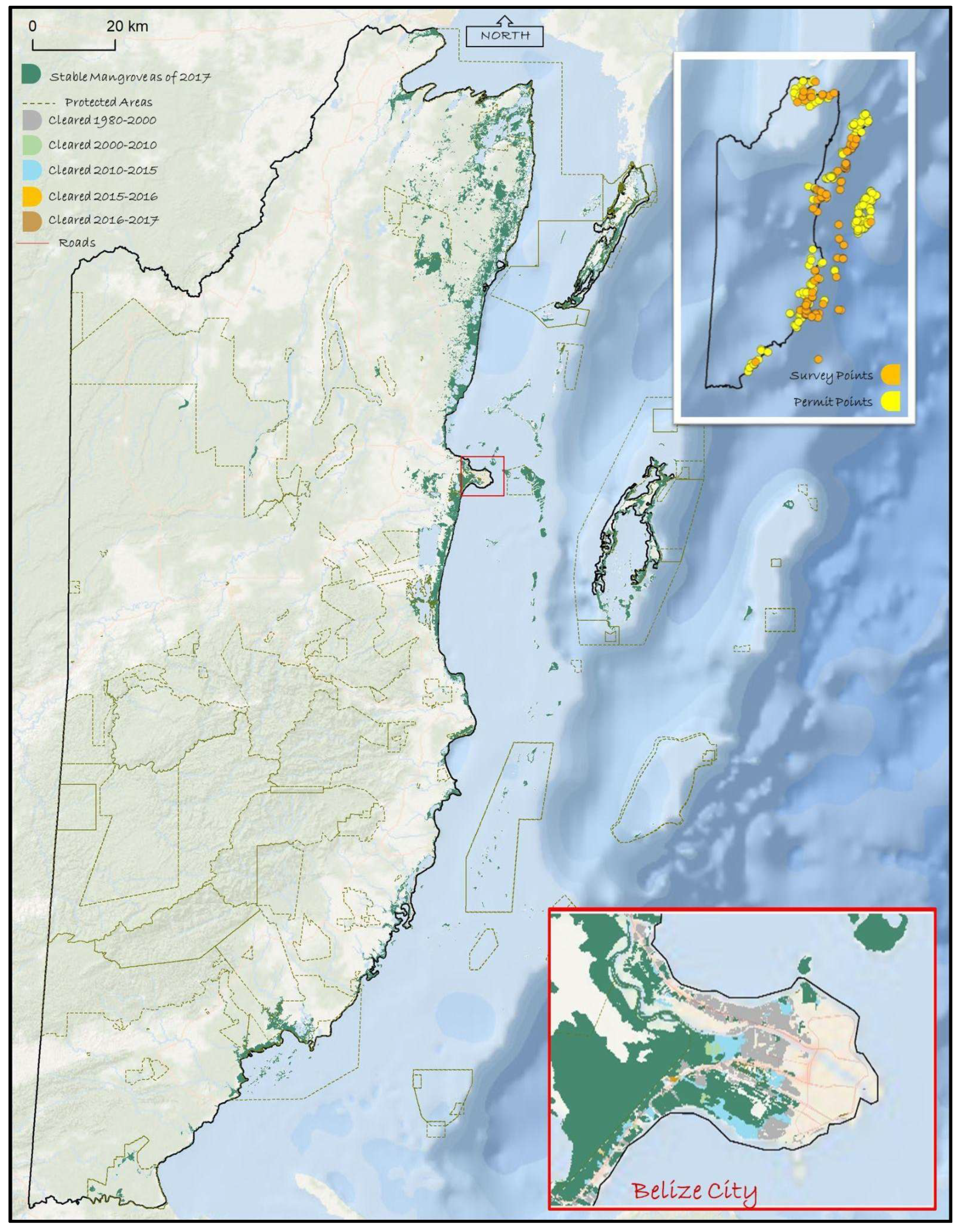
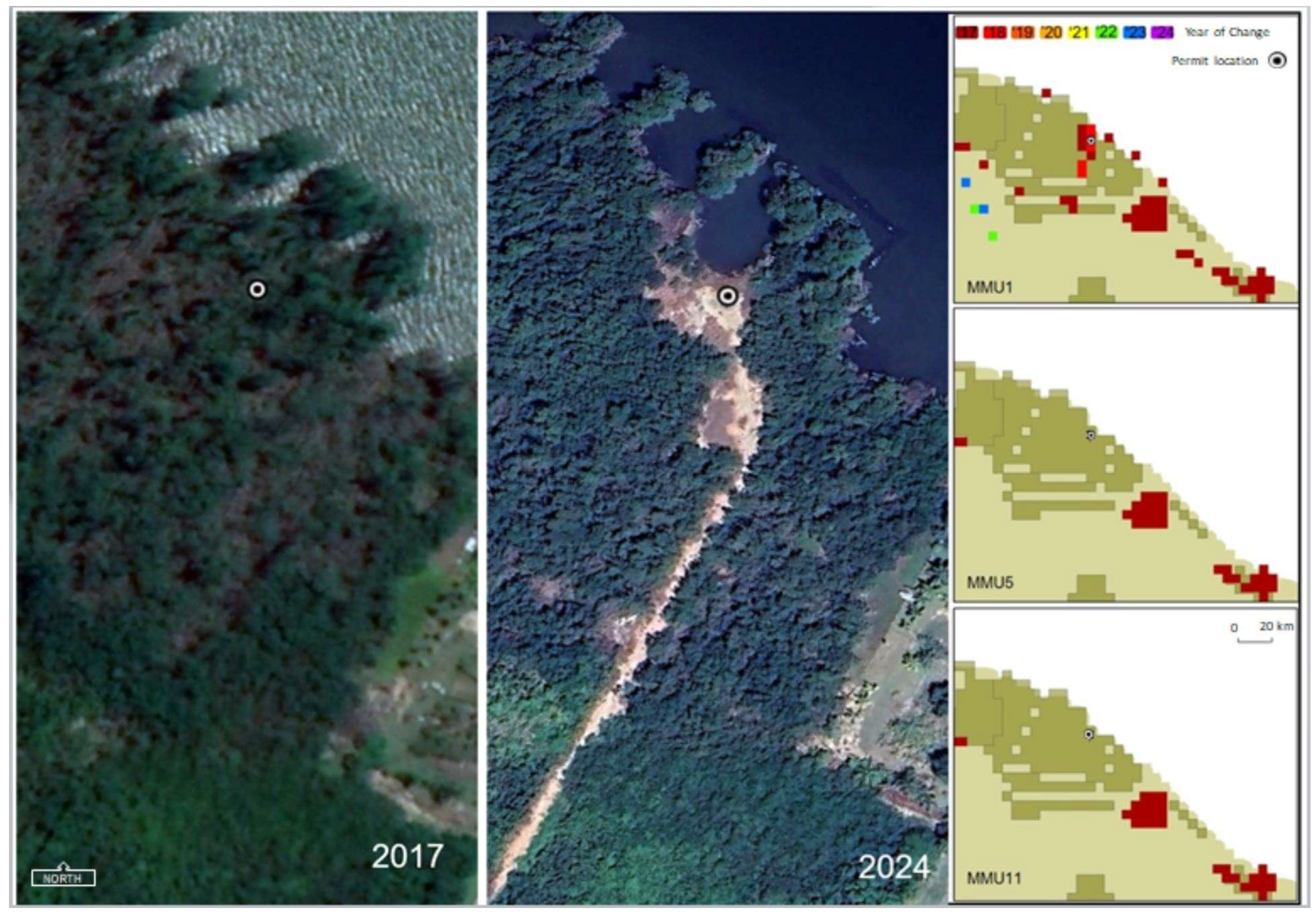
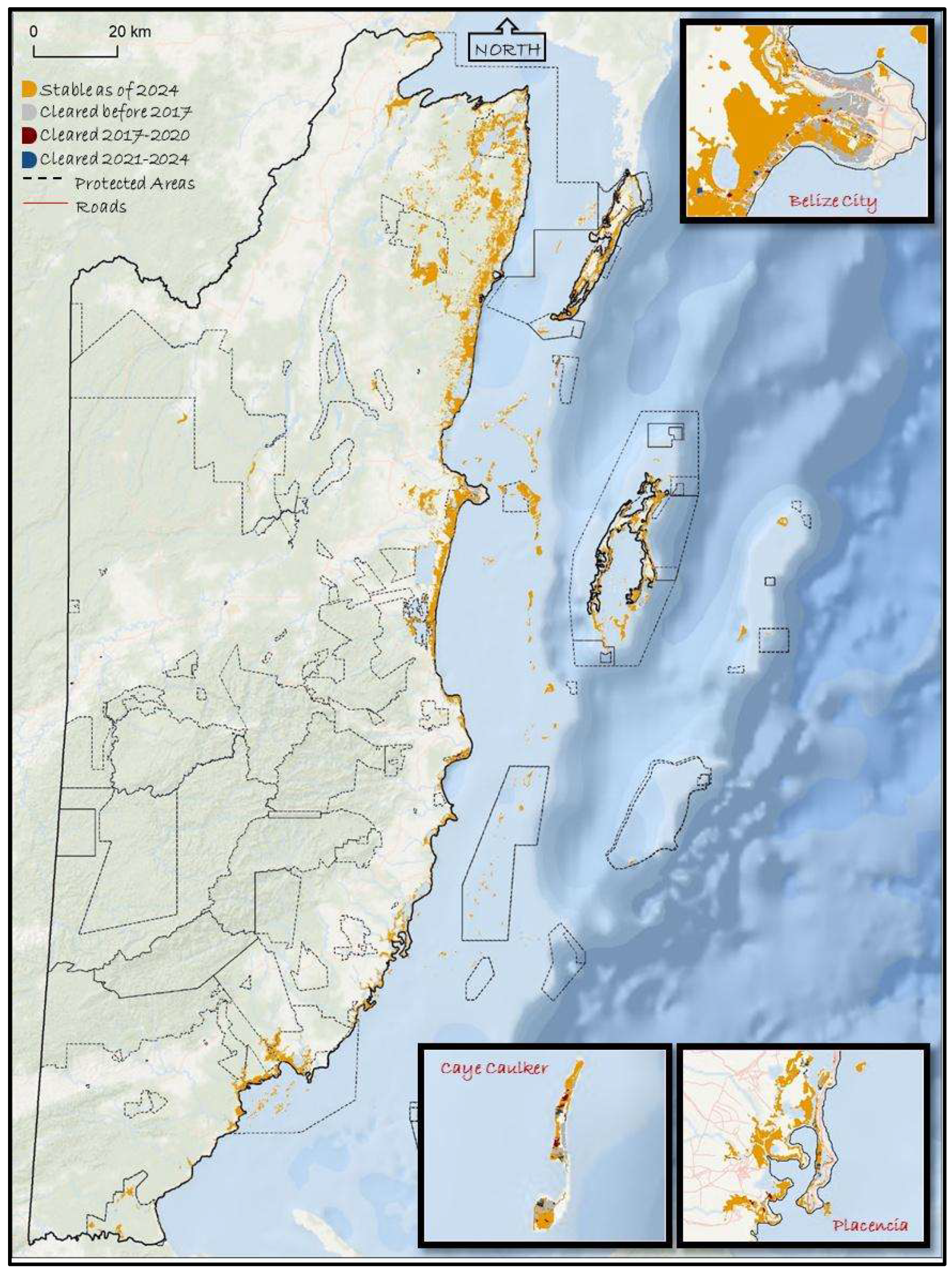
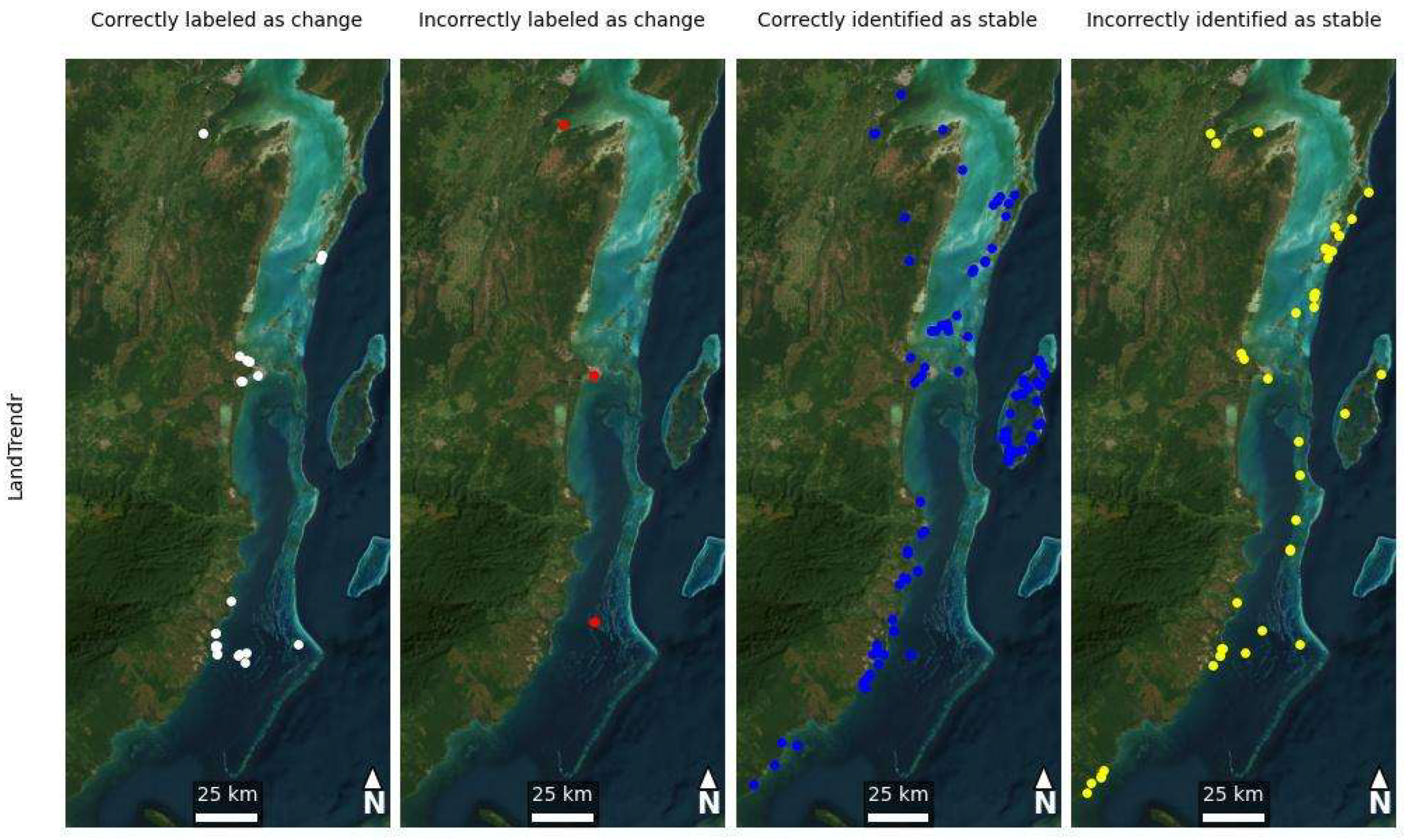
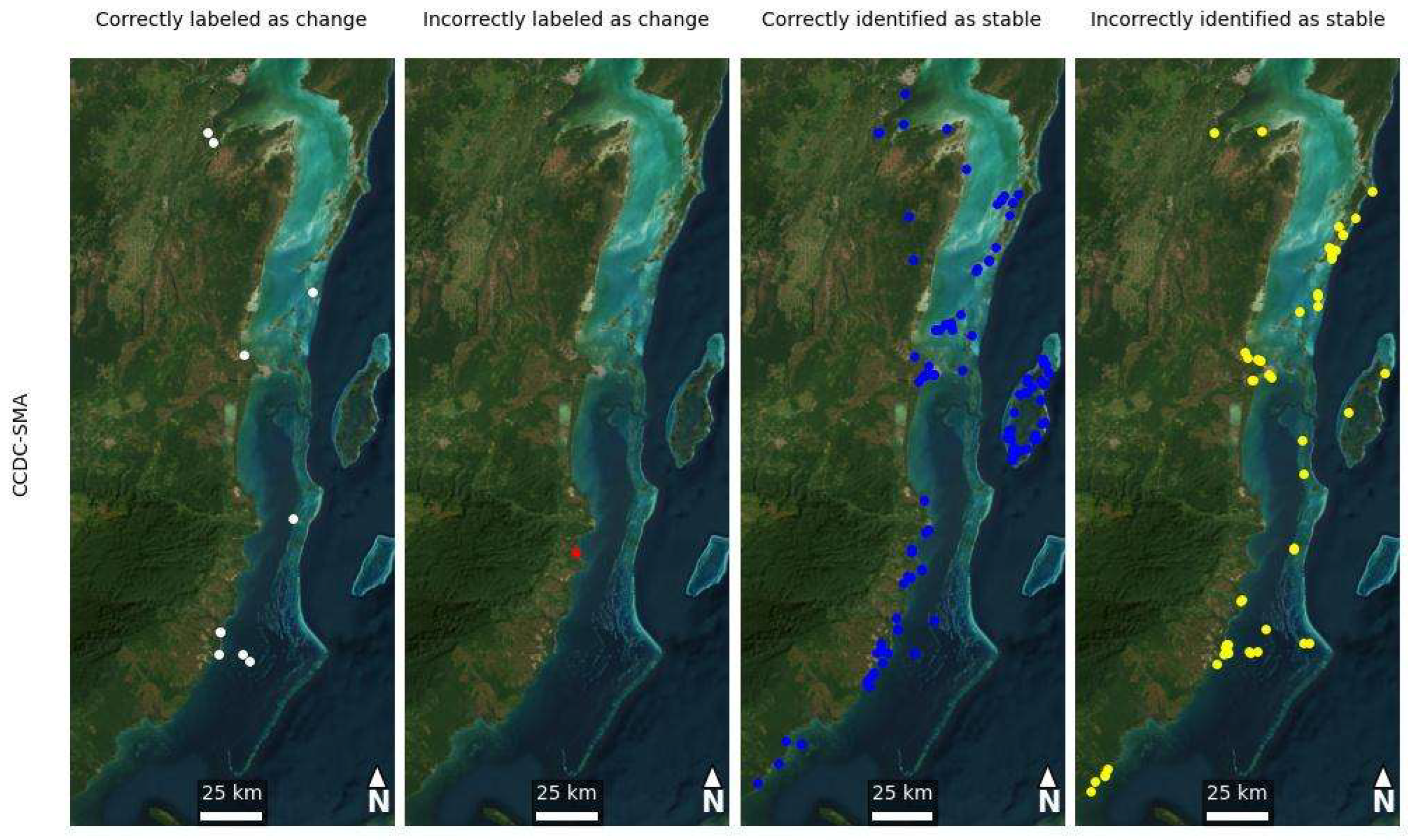

| Run Alias | Threshold | Change Probability | Number of Consecutive Changes | |
|---|---|---|---|---|
| Control | c0 | 0 | 0.99 | 5 |
| Parameter Variations | pv0x1 | 0 | 0.98 | 5 |
| pv0y1 | 0 | 0.99 | 8 | |
| pv0x3 | 0 | 0.98 | 8 | |
| Control | c2600 | 2600 | 0.99 | 5 |
| Parameter Variations | pv2600x1 | 2600 | 0.98 | 5 |
| pv2600y1 | 2600 | 0.99 | 8 | |
| pv2600x3 | 2600 | 0.98 | 8 | |
| Control | c7000 | 7000 | 0.99 | 5 |
| Parameter Variations | pv7000x1 | 7000 | 0.98 | 5 |
| pv7000y1 | 7000 | 0.99 | 8 | |
| pv7000x3 | 7000 | 0.98 | 8 | |
| Control | c10000 | 10,000 | 0.99 | 5 |
| Parameter Variations | pv10000x1 | 10,000 | 0.98 | 5 |
| pv10000y1 | 10,000 | 0.99 | 8 | |
| pv10000x3 | 10,000 | 0.98 | 8 |
| Run Alias | Max Segments | Spike Threshold | Vertex Count Overshoot | Prevent One Year Recovery | Recovery Threshold | Pval Threshold | Best Model Proportion | Min Observations Needed | Magnitude | Prevalue | MMU | |
|---|---|---|---|---|---|---|---|---|---|---|---|---|
| Control | MMU1 | 10 | 0.9 | 3 | TRUE | 1 | 0.05 | 0.75 | 3 | >300 | >300 | 1 |
| Parameter Variations | MS4 | 4 | 0.9 | 3 | TRUE | 1 | 0.05 | 0.75 | 3 | >300 | >300 | 1 |
| MS6 | 6 | 0.9 | 3 | TRUE | 1 | 0.05 | 0.75 | 3 | >300 | >300 | 1 | |
| MS12 | 12 | 0.9 | 3 | TRUE | 1 | 0.05 | 0.75 | 3 | >300 | >300 | 1 | |
| RT025 | 10 | 0.9 | 3 | TRUE | 0.25 | 0.05 | 0.75 | 3 | >300 | >300 | 1 | |
| RT05 | 10 | 0.9 | 3 | TRUE | 0.50 | 0.05 | 0.75 | 3 | >300 | >300 | 1 | |
| RT075 | 10 | 0.9 | 3 | TRUE | 0.75 | 0.05 | 0.75 | 3 | >300 | >300 | 1 | |
| BMP05 | 10 | 0.9 | 3 | TRUE | 1 | 0.05 | 0.5 | 3 | >300 | >300 | 1 | |
| BMP1 | 10 | 0.9 | 3 | TRUE | 1 | 0.05 | 1 | 3 | >300 | >300 | 1 | |
| BMP125 | 10 | 0.9 | 3 | TRUE | 1 | 0.05 | 1.25 | 3 | >300 | >300 | 1 | |
| Final Parameterization | Final | 4 | 0.9 | 3 | TRUE | 0.50 | 0.05 | 1 | 3 | >300 | >300 | 1 |
| Best Performing Algorithm Run | Annual Change in Mangroves (ha.) Detected by Change Detection Algorithms | Combined (2017–2024) Change Within Protected Areas (ha.|% Total Change) | |||||||||
|---|---|---|---|---|---|---|---|---|---|---|---|
| 2017 | 2018 | 2019 | 2020 | 2021 | 2022 | 2023 | 2024 | Total | |||
| LandTrendr (Final) | 34.20 | 44.03 | 48.82 | 144.99 | 55.35 | 70.67 | 76.93 | 65.01 | 540.01 | 135.58 | 25.11% |
| CCDC-SMA (c2600) | 202.18 | 123.24 | 816.63 | 125.93 | 96.48 | 111.93 | 232.36 | 378.36 | 2087.11 | 356.07 | 17.06% |
| What Is the Monitoring Priority? | CCDC-SMA | LandTrendr |
|---|---|---|
| Better certainty of change | Example: run c2600 | Example: run MMU1 |
| Increasing the change threshold resulted in a more restrictive change detection. A model with higher recall and lower false positives prioritizes this. | Lowering the MMU, while producing more false positives, it successfully identified more actual mangrove loss events, making it suitable when the priority is ensuring real changes are not missed. | |
| Better certainty of stability | Example: run pv0x1 | Example: runs MMU11, MMU5, or BMP125 |
| Lowering the change threshold resulted in a more inclusive change detection, meaning more false positives. However, there is also more certainty that pixels classified as unchanged are truly stable. | Although missing some key locations of mangrove loss, increasing MMU or BMP parameters provides higher confidence that areas classified as stable are truly unchanged. |
Disclaimer/Publisher’s Note: The statements, opinions and data contained in all publications are solely those of the individual author(s) and contributor(s) and not of MDPI and/or the editor(s). MDPI and/or the editor(s) disclaim responsibility for any injury to people or property resulting from any ideas, methods, instructions or products referred to in the content. |
© 2025 by the authors. Licensee MDPI, Basel, Switzerland. This article is an open access article distributed under the terms and conditions of the Creative Commons Attribution (CC BY) license (https://creativecommons.org/licenses/by/4.0/).
Share and Cite
Evans, C.; Carey, L.; Guerra, F.; Cherrington, E.A.; Correa, E.; Quintero, D. Cloud-Based Solutions for Monitoring Coastal Ecosystems and the Prioritization of Restoration Efforts Across Belize. Remote Sens. 2025, 17, 3396. https://doi.org/10.3390/rs17203396
Evans C, Carey L, Guerra F, Cherrington EA, Correa E, Quintero D. Cloud-Based Solutions for Monitoring Coastal Ecosystems and the Prioritization of Restoration Efforts Across Belize. Remote Sensing. 2025; 17(20):3396. https://doi.org/10.3390/rs17203396
Chicago/Turabian StyleEvans, Christine, Lauren Carey, Florencia Guerra, Emil A. Cherrington, Edgar Correa, and Diego Quintero. 2025. "Cloud-Based Solutions for Monitoring Coastal Ecosystems and the Prioritization of Restoration Efforts Across Belize" Remote Sensing 17, no. 20: 3396. https://doi.org/10.3390/rs17203396
APA StyleEvans, C., Carey, L., Guerra, F., Cherrington, E. A., Correa, E., & Quintero, D. (2025). Cloud-Based Solutions for Monitoring Coastal Ecosystems and the Prioritization of Restoration Efforts Across Belize. Remote Sensing, 17(20), 3396. https://doi.org/10.3390/rs17203396






